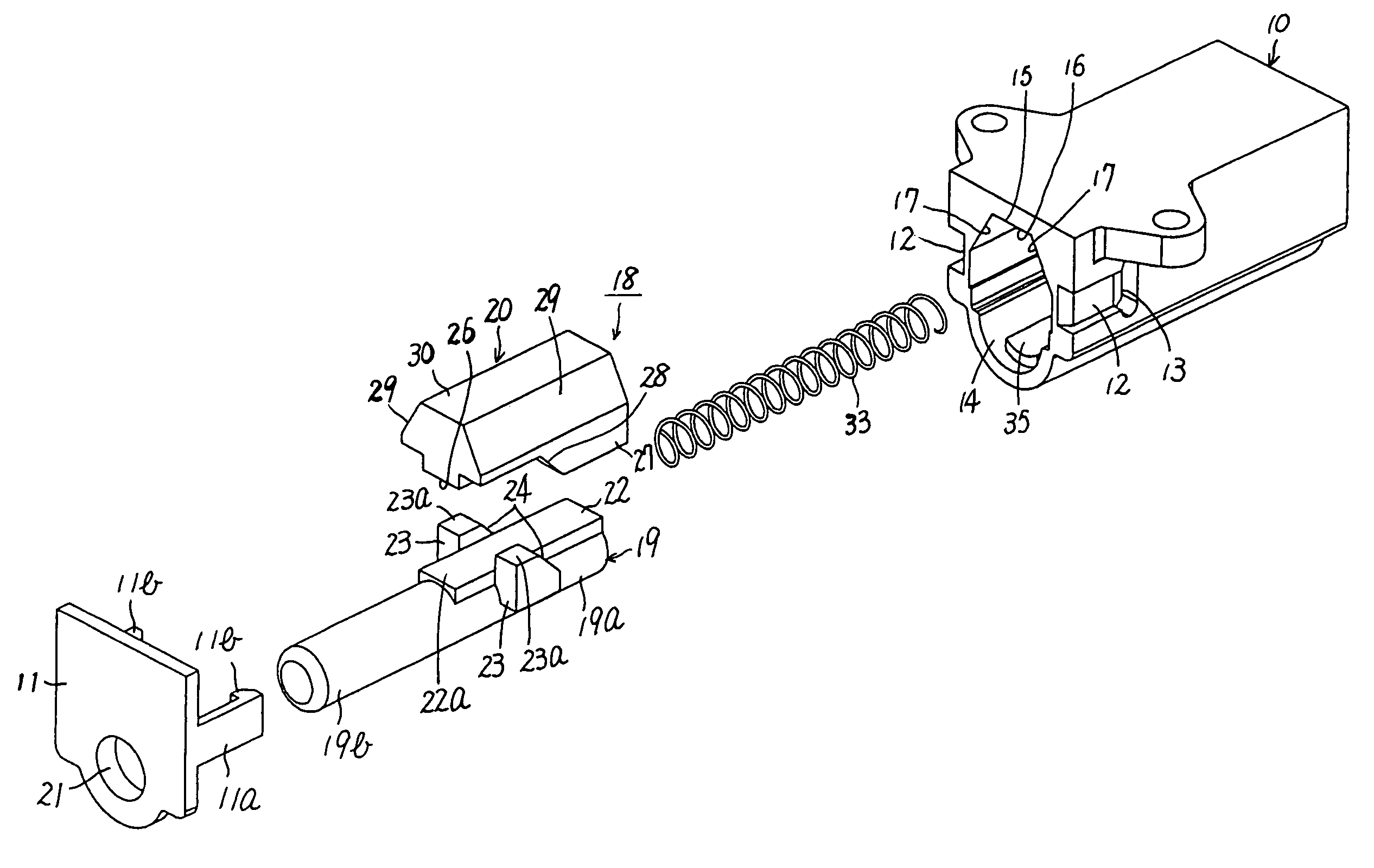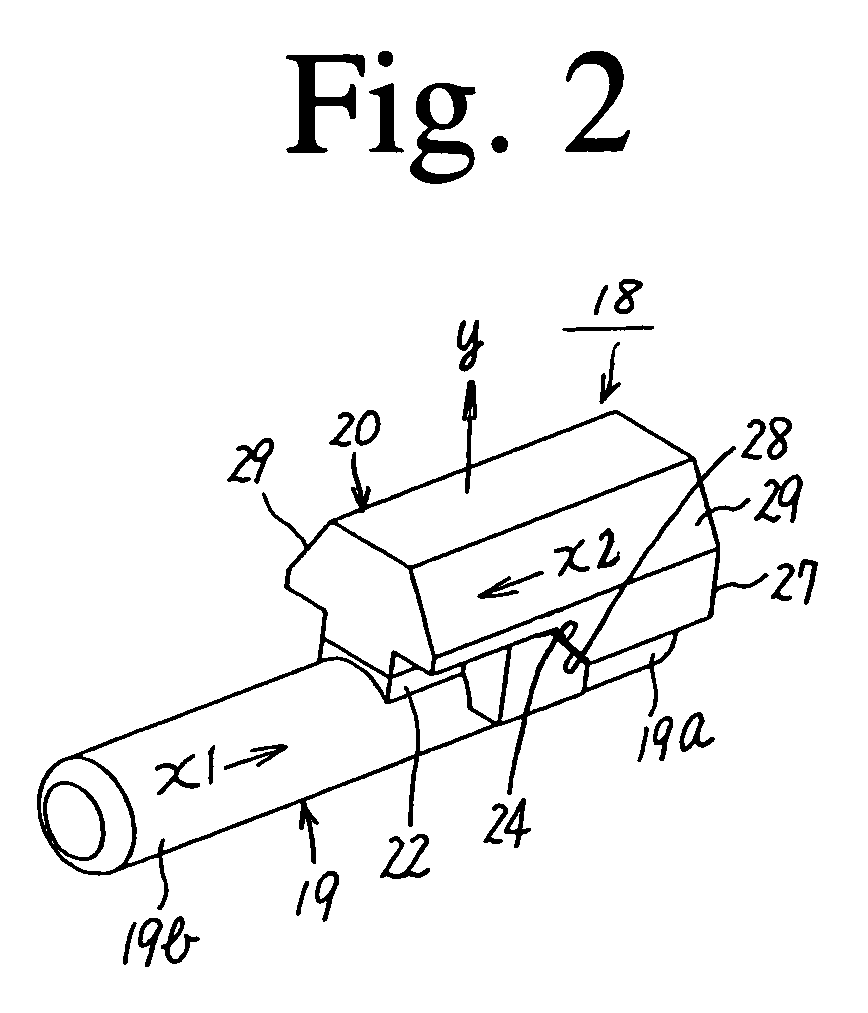Linear damper
a damper and linear technology, applied in the direction of friction dampers, solid based dampers, springs/dampers, etc., can solve the problems of inability to use oil dampers, virtually impossible to eliminate oil leakage in reality, and inability to completely eliminate oil leakage, etc., to avoid damper effect degradation, reduce costs, and high response
- Summary
- Abstract
- Description
- Claims
- Application Information
AI Technical Summary
Benefits of technology
Problems solved by technology
Method used
Image
Examples
first embodiment
[0101]FIG. 1 to FIG. 6 illustrate a first embodiment according to the present invention.
[0102]As shown in FIG. 1, a casing according to the present invention is constituted of a cylindrical-shaped casing body 10 and a cap 11. The casing body 10 has a closed end and an open end having an opening closed with the cap 11.
[0103]The cap 11 forming part of the casing has a pair of hooks 11a extending from the side faces of the cap 11. A pallet 11b is formed at the leading end of each hook 11a.
[0104]The casing body 10, correspondingly, has a pair of grooves 12 formed in both sides of the opening thereof. Each hook 11a snugly fits into the corresponding groove 12 when the cap 11 is fitted on the casing body 10. The groove 12 has an engaging recess 13 formed therein for receiving the pallet 11b when the hook 11a is snugly fitted into the groove 12. The pallets 11b of the hooks 11a are individually fitted into the engaging recesses 13 in this manner in order to prevent the cap 11 from disjoin...
third embodiment
[0148]FIG. 9 to FIG. 16 illustrate a third embodiment according to the present invention.
[0149]As shown in FIG. 9, a casing according to the present invention is constituted of a cylindrical-shaped casing body 10 and a cap 11. The casing body 10 has a closed end and an open end having an opening closed with the cap 11.
[0150]The cap 11 forming part of the casing has a pair of hooks 11a extending from the side faces of the cap 11. A pallet 11b is formed at the leading end of each hook 11a. Correspondingly, the casing body 10 has a pair of grooves 12 formed on both sides of the opening thereof. Each of the hooks 11a snugly fits into the corresponding groove 12 when the cap 11 is fitted on the casing body 10. The groove 12 has an engaging recess 13 formed therein for receiving the pallet 11b when the hook 11a is snugly fitted into the groove 12. The pallets 11b of the hooks 11a are respectively fitted into the engaging recesses 13 in this manner in order to prevent the cap 11 from disjo...
fifth embodiment
[0205]FIG. 19 to FIG. 23 illustrate a fifth embodiment according to the present invention.
[0206]As shown in FIG. 19, a casing according to the present invention is constituted of a cylindrical-shaped casing body 10 and a cap 11. The casing body 10 has a closed end and an open end having an opening closed with the cap 11.
[0207]As in the case of the first embodiment, the casing body 10 has a cylindrical portion 14 and a damping groove 15 formed inside in the axial direction. The cylindrical portion 14 and the damping groove 15 have the axes parallel to each other but the axis of the damping groove 15 is eccentric with respect to the cylindrical portion 14. The cylindrical portion 14 and the damping groove 15 are connected continuously to each other in the vertical direction.
[0208]The cylindrical portion 14 has an arc-shaped inner bottom portion formed opposite the damping groove 15 as shown in FIG. 20. The damping groove 15 has a flat ceiling face 16 opposing the cylindrical portion 1...
PUM
 Login to View More
Login to View More Abstract
Description
Claims
Application Information
 Login to View More
Login to View More - R&D
- Intellectual Property
- Life Sciences
- Materials
- Tech Scout
- Unparalleled Data Quality
- Higher Quality Content
- 60% Fewer Hallucinations
Browse by: Latest US Patents, China's latest patents, Technical Efficacy Thesaurus, Application Domain, Technology Topic, Popular Technical Reports.
© 2025 PatSnap. All rights reserved.Legal|Privacy policy|Modern Slavery Act Transparency Statement|Sitemap|About US| Contact US: help@patsnap.com



